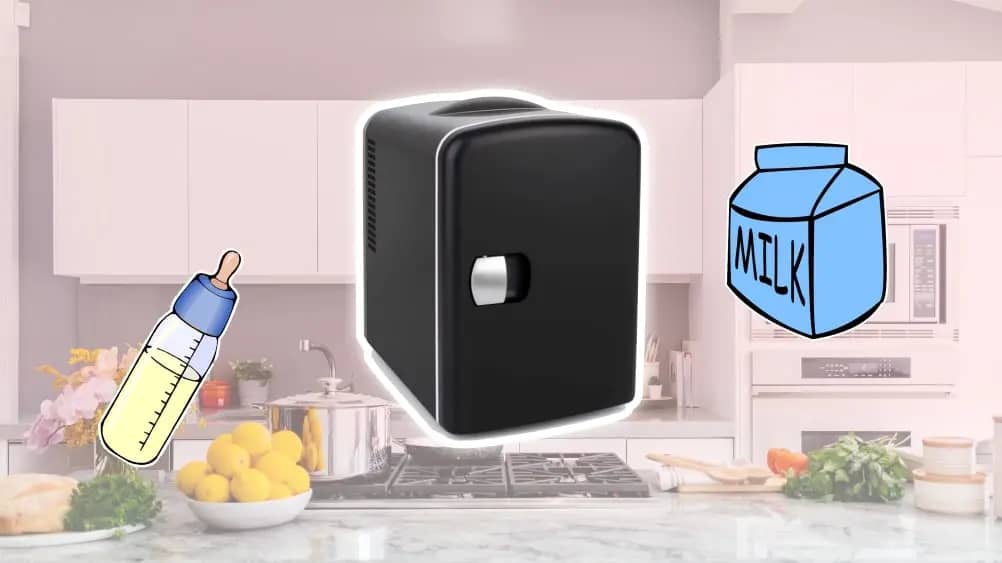A mini fridge is a small refrigerator designed to fit perfectly on a countertop or anywhere where there is not a lot of space. These small appliances provide the same cooling power as a regular refrigerator, but they are much smaller and typically have less storage space.
Small fridges are great for people who live in apartments or smaller homes. They are also useful for people who travel or want to keep a separate cooling unit to store products. Many use a micro fridge to store makeup and other small items that don’t require a lot of space. Compact fridges, for example, are an excellent option for students because of their size.
Can I put milk in a mini fridge?
The short answer is yes. As long as you keep your mini fridge in a cool area, away from sun exposure and heat, you can safely keep milk. But why should you keep a mini fridge away from heat and sun? And what is the safe temperature to keep milk?
Why Should You Keep Your Mini Fridge Away From Heat?
There are two main reasons for this:
- Firstly, it will save you money on energy costs since the compressor won’t have to work as hard,
- and secondly, it will keep your food fresh longer since there’s less fluctuation in temperature.
It’s not surprising that the power needed to cool your mini refrigerator is a significant concern. Energy cost increases each year, and life is becoming more and more expensive. Mini fridges vary in energy use depending on the model, features, size, and technology. The smallest models use between 55 watts and 85 watts an hour while running, while the larger ones may use up to 350 watts an hour. In comparison, the average household refrigerator consumes about 500 watts of electricity, yielding 1,460 kilowatt-hours of energy a year. That equates to $200 per annum in the US. Mini fridges would cost half of that price, depending on their size, brand, model, and technology.
There have been rare cases of mini fridges malfunctioning because they were heating too much. A little bit like laptops when they overheat but with different outcomes. And since you need a mini fridge to preserve your milk, you don’t want it to overheat. Spoiled milk is terrible and can make people sick or harm newborn babies, so please take precautions.
What Is The Safe Temperature To Keep Milk?
The safe temperature to keep milk inside a fridge is between 37°F and 40°F. If the temperature rises, it will spoil quickly, and bacteria will grow. The FDA (US Food & Drug Administration) recommends keeping the refrigerator’s temperature at or below 40°F because bacteria thrive in warmer temperatures from 40°F to 145°F. That’s true for all perishables, not just milk.
Salmonella is a common bacteria that thrive in various food types. It may be present in raw poultry, eggs, beef, and unpasteurized dairy products. When you leave these items in a fridge with a temperature higher than 40°F, you risk having various bacteria having a party in your food and milk. So choosing an appropriate mini fridge to store your milk for you or your baby is essential.
What is the Mini Fridge Temperature Range?
There are a plethora of mini fridges on the market, and almost every big retailer sells them. Their thermostat can go from 30 F° to -4 F°. In addition, some micro-fridges can even heat up your food when you need it. You just have to switch the button from cold to hot.
When purchasing a mini fridge, it is crucial to carefully review the product description and ensure it offers the appropriate temperature range. Specifically, for milk, it is recommended to choose a fridge with a temperature ranging between 37°F and 40°F.
Conclusion: It is generally okay to keep milk in a mini fridge. Just make sure that the mini fridge is set to a temperature between 37°F and 40°F, which is the ideal range for keeping milk fresh. It’s also a good idea to use sealed containers and regularly check the fridge’s temperature to ensure the milk stays in good condition.

With over 15 years of experience in the appliance industry, I am a passionate advocate for efficient and stylish mini fridges. I specialize in energy-saving models and compact living solutions. As a certified appliance repair technician, I have a deep understanding of mini fridge maintenance and troubleshooting.


1 thought on “Can I Put Milk In A Mini Fridge?”